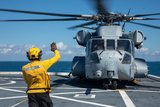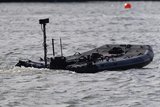Netherlands sets out schedule for naval point defence after Goalkeeper
The Dutch government has finalised plans for a successor system to the Goalkeeper CIWS.
‘Now that the investigation has been completed, the purchase contracts need to be settled. They will probably be closed in 2022,’ the MoD announced on 14 January.
The new system will be installed on both Royal Netherlands Navy Rotterdam-class landing platform dock vessels, as well as the joint logistics support ship HNLMS Karel Doorman and the two Anti-Submarine Warfare Frigates planned to enter service in 2028-2030.
A budget of €100 million to €250 million is required for the new CIWS.
HNLMS Den Helder — a new combat support ship to be delivered to the RNLN in 2024 — is also expected to feature the new-generation CIWS ‘but is not yet provided with it for budgetary reasons’, the MoD noted.
Defence minister Barbara Visser explained that the Thales-made Goalkeeper is approaching the end of its service life in 2025, despite completion of a modernisation programme in 2018.
The Dutch MoD and defence research organisation TNO assessed the threat to naval vessels from anti-ship missiles, unguided missiles, UAVs and piloted aircraft, as well as highly manoeuvrable attack boats armed with a variety of weapon systems.
They identified two types of ammunition for any successor point defence system to Goalkeeper: the RIM-116 Rolling Airframe Missile (RAM), which requires a shipboard launcher; and the DART sub-calibre guided projectile fired from a OTO Melara 76mm gun.
RAM has minimal shipboard control systems and will be autonomous after launch, whereas DART will be guided to its target by the BEL-Thales Pharos radar. Thales Nederland will make the radar and fire control for both systems.
Most components for the new CIWS will be available from 2025, apart from Pharos which is expected to be installed from 2028. The MoD admitted that the RNLN will only initially have a partial capability but the new system ‘already means a significant improvement over the Goalkeeper’.
About 70 units of the CIWS have been delivered to navies worldwide, according to Shephard Defence Insight.
As part of our promise to deliver comprehensive coverage to our Defence Insight and Premium News subscribers, our curated defence news content provides the latest industry updates, contract awards and programme milestones.
Related Equipment in Defence Insight
More from Naval Warfare
-
![UK to join US Navy’s Virginia-class submarine assembly effort to speed up construction]()
UK to join US Navy’s Virginia-class submarine assembly effort to speed up construction
The expansion of the Virginia-class submarine construction to UK shores could accelerate the project as US shipbuilders continue to fall short of delivery goals.
-
![US Navy seeks new sensors for the CH-53K King Stallion heavy-lift helicopter]()
US Navy seeks new sensors for the CH-53K King Stallion heavy-lift helicopter
The US Navy intends to publish a draft request for proposals in Q2 2026 and conduct an open competition for the supply of new electro-optical and infrared capabilities for the CH-53K heavy-lift helicopter.
-
![What new technologies could be involved in UK Atlantic Bastion initiative?]()
What new technologies could be involved in UK Atlantic Bastion initiative?
As new details emerge on the UK Royal Navy’s plan to secure the North Atlantic for the UK and NATO, three main areas of opportunity for new technology are the focal point.
-
![NATO naval exercises map out future USV requirements but raise questions on acquisition]()
NATO naval exercises map out future USV requirements but raise questions on acquisition
Uncrewed surface vessels have shifted from a desirable capability to a critical one for navies. But should these systems be bought outright, rented as a service or rapidly built using commercial off-the-shelf components?






















